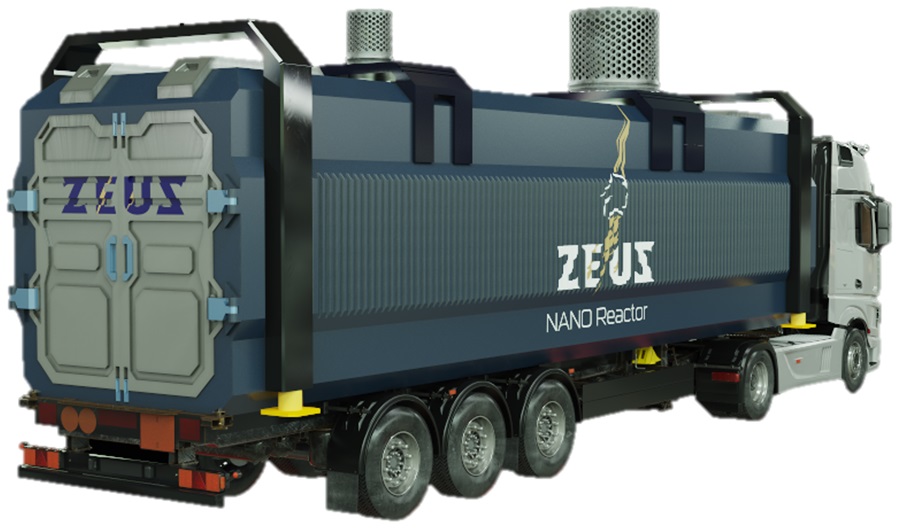In a politically polarized U.S. striving to lower greenhouse-gas emissions while meeting seemingly insatiable electricity needs, a form of energy is shaking loose a longtime stigma.
Nuclear energy is gearing up for a potential rebirth.
But the technology is not the same as yesteryear.
Advanced small modular reactors (SMR), which typically pack up to about 300 megawatts (MW) of power, and smaller microreactors that usually have a capacity of less than 50 MW—are being weighed as an alternative power source by companies that include Permian Basin oil players and utilities in other parts of the U.S.
Championed for their smaller footprints, mobility and lower costs compared to larger nuclear plants, the nuclear reactor units are seen as a promising route to around-the-clock, emissions-free, baseload dispatchable power. Focus on nuclear energy has been gaining ground amid the continued drive to decarbonize while maintaining reliable access to power.
“There’s a huge economic opportunity here to be an early player in these nuclear technologies for industrial applications because everyone’s saying that demand is coming in very large quantities,” Benton Arnett, senior director of markets and policy for the Nuclear Energy Institute (NEI), told Oil and Gas Investor.

Electricity demand in West Texas’ Permian Basin alone is expected to increase significantly from 2022 to 2038, according to the Electric Reliability Council of Texas’ (ERCOT) Permian Basin Reliability Plan Study that modeled loads that will need power. The study showed the load could reach nearly 23.7 gigawatts (GW) in 2030, more than double the 10.5 GW that a 2021 Permian Basin study projected by 2030.
Of the forecasted 2030 load, Permian Basin oil and gas accounts for about 12 GW, while non-oil and gas demand—such as crypto, green hydrogen, commercial/industrial and data centers—accounts for about 11.7 GW. The non-oil and gas load was zero in the 2021 report, and ERCOT says that all but 6% of the anticipated 11.7 GW is confirmed by letter or contract.
That’s just in the Permian Basin. The story of rising electricity demand is playing out across the U.S.
Higher anticipated demand is likely to bring along transmission needs, adding more stress to overwhelmed, aging electric grids.
“The question is, where’s the generation going to come from? Who’s going to build these generators? Who’s going to build the poles and the wires to distribute all of that power?” said Nick Morriss, director of business development for Shepherd Power, the nuclear energy unit of NOV. “A lot of energy producers in West Texas are saying, well, we might have to do this ourselves.”
In steps nuclear energy—more specifically, microreactors.
Aiming for critical mass
Talk of nuclear power revivals have surfaced in the past. However, costs, regulatory barriers and safety concerns lingering from a few accidents have prevented nuclear from taking off.
“What’s different about this one, at least in our opinion, is that there’s a really broad diversity of products that are in development right now,” Morriss said, referring to SMRs, microreactors and other key technology breakthroughs in nuclear energy. “We think there’s good potential there.”

Among these advancements is TRISO fuel, which stands for tri-structural isotropic particle fuel.
Some past nuclear energy accidents were compounded when the fuel melted and radioactive elements released into the atmosphere, he said. However, TRISO fuel enables a step change in how fuels are manufactured, making them safer.
As explained by the U.S. Department of Energy (DOE), each TRISO particle—about the size of a poppy seed—is comprised of a uranium, carbon and oxygen fuel kernel, which is “encapsulated by three layers of carbon- and ceramic-based materials that prevent the release of radioactive fission products.” The particles can withstand extreme temperatures and are more resistant than traditional reactor fuels when it comes to neutron irradiation, corrosion, oxidation and high temperatures, according to the DOE.
TRISO fuels, which enable smaller designs and improved efficiency, are being used for SMRs and microreactors.
“We have a lot of industries that consume heat, not necessarily electricity. The reason why they’ve never really considered nuclear was because nobody wants to have a 500-acre nuclear plant next to their refinery or next to their industrial facility,” Morriss said. “So, these microreactors that are fueled by this TRISO fuel form can be very small—like 20-foot shipping containers small in some cases. So, you can start to integrate them into different types of facilities. That fuel form is really one of the breakthroughs.”
From spent to spending
The advancements come as startups join more experienced manufacturers of nuclear components, working to roll out new tech and open facilities.
Nano Nuclear Energy, an emerging microreactor technology company, is advancing its technology following its IPO in May. Its technologies include Zeus, a solid core battery reactor, and ODIN, a low-pressure coolant reactor. Both are portable, on-demand capable, advanced nuclear microreactors.

California-based Oklo said it plans to deploy its first commercial advanced reactor in the U.S. before the end of the decade. The company’s fuel source is “millions of times more energy dense, resulting in millions of times less land impacted by mining and increased reliability of fuel resources” compared to fossil sources such as natural gas and coal. Its fission power plants, which can run on recycled or nonrecycled fuel for decades without refueling, can be located wherever power is needed, according to the company.
Earlier this year, Diamondback Energy signed a 20-year power purchase agreement with Oklo for a 50-MW small nuclear reactor unit for its Permian operations. The company also landed a $10 million investment from U.S. pressure pumper Liberty Energy.
Longtime player Westinghouse, which has a 5-MWe microreactor called eVinci, is collaborating with Prodigy on floating nuclear power plants. BWX Technologies is assessing the viability of deploying small-scale nuclear reactors in Wyoming, among other projects. Dow and X-Energy Reactor are developing their first Xe-100 advanced small modular reactor plant at Dow’s Seadrift, Texas, facility.
There are a “lot of different technology options for these players,” Arnett said. Permian Basin operators are looking at microreactors, lured by their ability to serve as portable electricity generators that provide reliable carbon-free power.
“This isn’t the only industry that we’re seeing looking towards micros to create this kind of flexibility,” Arnett said. “The Department of Defense has also been really active in developing microreactors for forward operating bases.”
Virginia-based utility Dominion Energy put out a request for proposals from leading SMR nuclear technology companies as it evaluates using a SMR at the North Anna Power Station in Louisa County, Virgina.
Known for its oilfield equipment and technology, NOV established a unit focused on developing and deploying microreactors to help meet dispatchable power needs for not only oil and gas but also other industries.
“We are willing to buy, own and operate these microreactors in exchange for energy purchase agreements with oil and gas companies,” Morriss said.
Shepherd Power essentially is a technology aggregator that builds the fleet of reactors and associated financial models for oil companies looking to electrify or build out new process heat systems for operations, according to Morriss. Shepherd will site, own and operate the reactors on behalf of the companies.
Microreactors can fit in any part of the oil and gas industry’s main value chains: upstream, midstream and downstream. “It’s not just the Permian,” Morriss said, adding there’s “no silver bullet just yet” in terms of applications.
Another advantage is that microreactors don’t have to be connected to an electric grid. They can operate independently, or as part of a grid or microgrid.
Nuclear reactors have supplied about 20% of the power in the U.S. since the 1990s, according to the DOE. In 2023, nuclear power plants generated 775 billion kilowatt hours, enough to power more than 73 million homes.

Lowering nuclear costs
Despite the growing interest and advantages, nuclear energy still has hurdles to overcome.
“Nuclear has a reputation of major cost overruns and timeframes. When you look at the Vogtle facility, which is the last large nuclear facility … just completed in Georgia, it was way over budget, way over a few years beyond when it was supposed to come online,” said Jack Belcher, principal with Washington, D.C-based Cornerstone Government Affairs. “That is kind of the reputation hurdle that SMRs face. It’s a different technology. We hope that it’s a different risk profile, but it is new.”
Decades ago, lowering costs and achieving economic viability typically meant building larger plants, Morriss said.
“There’s another way to scale, and that is, you build a lot of them. And we’ve seen examples of this in countries like France,” where units have been standardized and built at lower costs, he said. “In oil and gas, we experience this all the time. We built a lot of mega projects as an industry. And, NOV specifically [has] played a lot in offshore markets where we built drillships, for example, and we’ve lived serial production cost curve reductions over decades.”
A similar path is required to bring down nuclear energy costs. The energy source wins on emissions but losses when it comes to costs when compared to natural gas, for example.
“You’ve got to remunerate early adopters with savings that are realized as those costs come down over time,” Morriss said. “It’s really a financial challenge more than a technology challenge.”
A study conducted by Lux Research showed the levelized cost of electricity of SMRs, for example, can be 25% to 60% lower than large-scale reactors, depending on location, if they are serially produced.
“Many developers are still in various stages of development and licensing, so it’s hard to gauge if SMRs can climb the learning curve quickly and prove economic benefits,” the study states.
Deployment of microreactors is also sensitive to production rates. Regulatory fees paid per reactor could hinder serial production rates, according to Lux.
Threat assessment
Nuclear technology carries a lingering stigma associated with atomic weapons, accidents and waste. A lawsuit involving the burial of nuclear waste is playing out in the Permian Basin.
As talk of microreactors and SMRs heats up, Arnett encourages people concerned about nuclear energy to learn about the technology.
“The nuclear industry certainly needs to do a better job, I think, of telling that story. But, what we found is that when we go into communities and we start actually talking with folks about what the operational realities of these reactors are, the kinds of rigorous safety tests they go through,” he said, “the kind of oversight they’re going to continue to have both during construction and operation for the entire life of the reactor. And we look at the safety record of the nuclear fleet as a whole. I think folks really start to understand the technology and they get a lot more comfortable with it.”
Plus, there are downfalls to all kinds of energy technologies, Arnett said, using air pollution and coal production as an example.
Regulations can help alleviate some of the risks.
“Right now, we are in a situation where … regulatory changes [are needed] to accommodate this new class of reactor. The Nuclear Regulatory Commission [NRC] designed all of their regulations around the idea of building these large, gigawatt-size style reactors, the old type of reactors that we used to build,” Arnett said. Getting regulators to think about the differences and the inherent safety features will be important, he added.
Legislators appear to be on that path. Nuclear energy has emerged as one of the few topics that has bipartisan support.
Getting aboard
The 2024 Accelerating Deployment of Versatile, Advanced Nuclear for Clean Energy (ADVANCE) Act overwhelmingly passed in the House and Senate.
“That’s remarkable right now—in an election year, to boot,” Morriss said.
The ADVANCE Act, signed into law by President Joe Biden in July as part of the Fire Grants and Safety Act, directs the NRC to lower certain licensing application fees for advanced nuclear reactor application reviews, authorizes more staff to carry out reviews and introduces prize competitions to incentivize deployment of advanced reactor technology. It also directs the NRC to develop guidance to license and regulate microreactor designs within 18 months.
“We’ve finally seen the policy support in Washington from both sides of the aisle, strong bipartisan support … to move forward with nuclear as a solution,” Arnett said. “I do think we’re on the cusp of a really big breakthrough in the industry.”
Efforts are also underway in states to advance nuclear energy. The Texas Advanced Nuclear Reactor Working Group was formed in 2023 to evaluate advanced nuclear reactors in the state, focusing on areas that include financial incentives, state and federal regulatory impediments to growth, Texas electric market impacts, technical challenges, and other factors, according to the Texas Public Utility Commission. Its findings and recommendations are due to Gov. Greg Abbott by Dec. 1.
“We’re working to accelerate things in Texas from the regulatory side to incentives to utilizing state resources to get nuclear into Texas on a rapid scale,” Belcher said. Nuclear energy’s use in the oil and gas sector is among the group’s areas of study.
“Oil and gas producers are looking at this in the same vein as manufacturers,” Belcher said. “They can’t afford to be without power and then when you look at isolated areas, SMRs make a lot of sense.… You can put them in remote areas and have reliable power.”
Data centers are also considering SMRs as demand for AI grows, he added.
Normalizing nuclear
Nuclear energy may be in a class of its own when it comes to delivering carbon-free reliable energy. Natural gas needs carbon capture and sequestration, a technology experiencing difficulties reaching scale, Arnett said, while renewables require batteries and transmission lines and geothermal has geographical limitations.
But moving nuclear energy forward and securing buy-in from Big Oil and other major energy users may ultimately come to cost.
“Our opinion is that a way to solve for that is to make these projects much, much smaller. And that’s where microreactors come in.… The only thing standing in the way of making those economical is you’ve got to build a whole lot of ’em,” Morris said. “We need to make these systems really small, really safe. And we need to make them applicable to a lot of industrial applications.”
He imagines a future—possibly 10 years from now—with SMRs at concrete plants, microreactors at drilling sites and maybe even small microreactors serving as a backup generator for grocery stores.
“People start to see these little devices in their daily lives. And that’s ultimately what dispels the fear,” Morriss said. “Then, we get to unlock nuclear energy for what it is, which is the most dense source of energy mankind’s ever created. We need to be taking advantage of that, and we need to stop walking backwards into intermittent renewables and these Rube Goldberg carbon capture schemes. Let’s get back to density, which is really the only form of energy transition that’s ever worked. And, let’s run head first in nuclear.”
Arnett said he is most hopeful about the nuclear industry’s partnership with the oil and gas sector.
“The nuclear industry certainly has a lot of knowledge to offer here, but the oil and gas industry’s the best industry in the world with delivering projects. I think they’re the only industry that delivers megaprojects on time, on budget,” Arnett said. “We can learn a lot from their operational knowledge and project management knowledge and really work together to make this a really successful future.”
Recommended Reading
Commercial Operations at Calcasieu Pass LNG to Begin in April
2025-02-18 - Venture Global started selling LNG at the plant in 2022, angering its long-term customers.
Bottlenecks Holding US Back from NatGas, LNG Dominance
2025-03-13 - North America’s natural gas abundance positions the region to be a reliable power supplier. But regulatory factors are holding the industry back from fully tackling the global energy crisis, experts at CERAWeek said.
EIA: NatGas Storage Plunges, Prices Soar
2025-01-16 - Frigid weather and jumping LNG demand have pushed natural gas above $4/MMBtu.
Baker Hughes Wins LNG Technology Orders for Venture Global
2025-01-30 - Baker Hughes Co. also signed a multiyear services agreement to support the first two phases of Venture Global’s Plaquemines LNG project in Louisiana.
Excelerate Energy Hits Record on Ship-To-Ship LNG Transfers
2025-01-07 - Excelerate completed 3,000 ship-to-ship transfers onboard a platform in Bangladesh.
Comments
Add new comment
This conversation is moderated according to Hart Energy community rules. Please read the rules before joining the discussion. If you’re experiencing any technical problems, please contact our customer care team.






